-
Posts
1,734 -
Joined
-
Last visited
Content Type
Profiles
Forums
Gallery
Events
Posts posted by flying_dutchman2
-
-
- cristikc, Duanelaker, GrandpaPhil and 4 others
-
 7
7
-
Here are some of the last pictures of the 99.9% completed model. Flags still need some Dullcoat. The stand needs to be finished and the display case needs to be built. This will not happen for several months as I am very busy at work.
Spring started really late so everything is extended. Furthermore, due to the killer cold winter we had, there is a need for many replacement plants needed in the landscape. I order 50 - 3 gls pot, red roses (Double Knockout) and they are out the door in a week. I just can't keep up with the demand. I manage a garden center.
So here goes
Marc
Flags are drying.
More drying.
-
Frank;
Thanks for the link to Inkscape. I will try this.
I did use progeCAD but I wasn't that satisfied with the results. (I know I spent much money on this) Changed to TurboCad and the IMSI forums have helped me tremendously.
I already use Delftship and GIMP.
The above combination works good for me. I am not a student or teacher so I can't get cheap software.
Marc
-
-
Scott;
I wondered about this holiday as well and my wife who is 1/4 Chippewa always thought it was a joke as she tells whoever brings it up that the native Americans where on this continent way before anyone else. She also thinks there should be "Native American" day. They have a holiday for every ethnic minority but not them.
Wayne;
Interesting information. Thanks for sharing.
Marc
-
There is another book from Ab Hoving and Cor Emke, but it is not on the list. This will be for Summer or Fall. Similar boat as the Utrecht. Hoving & Emke are picking 10 or 15 of the many flat and round bottom boats in the Netherlands and writing a history and adding plans.
Just in time when I finish the Utrecht.
Marc
-
In the galleries on both sides of the ship where the toilets for the higher ranking people on the ship.
The "sewers" of these toilets where just simple pieces of copperpipe
Hans;
You are the first person that adds that detail to a ship. It is necessary and many a sailor fell through the hole in the ocean and drowned.
On another note. The details on the Batavia are beautiful. You are pretty much adding everything that is on the replica and probably on the original ship.
Marc
-
I picked up a book at gutenberg.org about the "History of Holland. Very interesting, very detailed and information I have never read before.
The following naval officer is famous of capturing four fleeing galleons trapped on the Cuban coast. Hein captured 11,509,524 guilders of booty in gold, silver, and other expensive trade goods, such as indigo and cochineal, without any bloodshed. The capture of the treasure fleet was the company's greatest victory in the Caribbean.
Pieter Pietersen Heyn (Hein) (25 November 1577 – 18 June 1629) was a Dutch naval officer and folk hero during the Eighty Years' War between the United Provinces and Spain.
Early life
Hein was born in Delfshaven (now part of Rotterdam), the son of a sea captain, and he became a sailor while he was still a teenager. In his twenties, he was captured by the Spanish, and served as a galley slave for about four years, probably between 1598 and 1602, when he was traded for Spanish prisoners. Between 1603 and 1607 he was again held captive by the Spanish, when captured near Cuba.
In 1607, he joined the Dutch East India Company and left for Asia, returning with the rank of captain (of the Hollandia) five years later. In 1618, when he was captain of the Neptunus, both he and his ship were pressed into service by Venice. In 1621 he left his vessel behind and traveled overland to the Netherlands.
In 1623, he became vice-admiral of the new Dutch West India Company (WIC) and sailed to the West Indies the following year. In Brazil, he briefly captured the Portuguese settlement of Salvador, personally leading the assault on the sea fortress of that town. In August with a small and undermanned fleet he sailed for the African west coast and attacked a Portuguese fleet in the strongly defended bay of Luanda but failed to capture any ships. He then crossed the Atlantic ocean again to try and capture merchant ships at the city of Vitória, but was defeated by a resistance organized by the local citizenry with the assistance of the Portuguese garrison. After finding that Salvador had been recaptured by a large Spanish-Portuguese fleet Hein returned home. The Dutch West India Company, pleased with Hein's leadership qualities, placed him in command of a new squadron in 1626. In subsequent raids during 1627 at Salvador, he attacked and captured over thirty richly laden Portuguese merchant ships before returning to the United Provinces.
Modern historians today often classify Hein as a pirate, though he was more properly a privateer; the Dutch Republic was locked in mortal combat with the Habsburgs and Hein was among the most successful and famous commanders it employed during the Eighty Years' War. While many privateers behaved no better than common pirates, Hein was a strict disciplinarian who discouraged unruly conduct among his crews and had rather enlightened views for the times about "Indian" tribes, slaves and members of other religions. Also, he never was an individual privateer but rather commanded entire fleets of warships.
Spanish treasure fleet
Battle in the Bay of Matanzas
In 1628, Admiral Hein, with Witte de With as his flag captain, sailed out to capture a Spanish treasure fleet loaded with silver from their American colonies and the Philippines. With him was Admiral Hendrick Lonck and he was later joined by a squadron of Vice-Admiral Joost Banckert, as well as by the pirate Moses Cohen Henriques. Part of the Spanish fleet in Venezuela had been warned because a Dutch cabin boy had lost his way on Blanquilla and was captured, betraying the plan, but the other half from Mexico continued its voyage, unaware of the threat. Sixteen Spanish ships were intercepted; one galleon was taken after a surprise encounter during the night, nine smaller merchants were talked into a surrender; two small ships were taken at sea fleeing, four fleeing galleons were trapped on the Cuban coast in the Bay of Matanzas.
After some musket volleys from Dutch sloops the crews of the galleons also surrendered and Hein captured 11,509,524 guilders of booty in gold, silver, and other expensive trade goods, such as indigo and cochineal, without any bloodshed. The Dutch didn't take prisoners: they gave the Spanish crews ample supplies for a march to Havana. The released were surprised to hear the admiral personally giving them directions in fluent Spanish; Hein after all was well acquainted with the region as he had been confined to it during his internment after 1603. The capture of the treasure fleet was the company's greatest victory in the Caribbean.
As a result, the money funded the Dutch army for eight months (and as a direct consequence, allowing it to capture the fortress 's-Hertogenbosch), and the shareholders enjoyed a cash dividend of 50% for that year. Hein returned to the Netherlands in 1629, where he was hailed as a hero. Watching the crowds cheering him as he stood on the balcony of the town hall of Leyden he remarked to the burgomaster: "Now they praise me because I gained riches without the least danger; but earlier when I risked my life in full combat they didn't even know I existed...". Hein was the first and the last to capture such a large part of a Spanish "silver fleet" from America.
Lieutenant-Admiral
He became, after a conflict with the WIC about policy and payment, Lieutenant-Admiral of Holland and West Frisia on 26 March 1629, and thus factual supreme commander of the confederate Dutch fleet, taking as flag captain Maarten Tromp. He died the same year, in a campaign against the Dunkirkers, the highly effective fleet of Habsburg commerce raiders and privateers operating from Dunkirk. As it happened his flotilla intercepted three privateers from Ostend. He deliberately moved his flagship in between two enemy ships to give them both simultaneous broadsides. After half an hour he was hit in the left shoulder by a cannonball and was killed instantly. He is buried in the Oude Kerk in Delft.
Commemoration
The Piet Hein Tunnel in Amsterdam is named in his honor, as is the former Dutch Kortenaer class frigate, Hr. Ms. Piet Heyn.
A direct descendant of Hein was Piet Hein, a famous 20th century Danish mathematician, physicist and poet.
A song praising Admiral Hein's capture of the Spanish "silver fleet" written in 1844 is still sung by choirs and children at primary school in the Netherlands.
(I learned this song as well and still remember this.)
Thanks for reading.
Marc -
To dgbot and Jack P. thanks for the answer to my question. Will go to my nearest hobby shop and locate a little bottle.
Marc
-
The flags look great, Marc.
I think if you hit them with a little Dulcoat, they'll lose that "too bright" look.
Thanks Dan. What is Dulcoat? I think Kurt mentioned that as well in the last meeting.
Marc
-
As I am very busy with work there is little time for modeling but I did finish the flags and will work on it some more later on today. The flags fall nicely but I think the colors are too bright. I checked numerous paintings and pictures of replicas and on the replicas they are pretty bright as well.
So what do other members think?
Marc
- Piet, GrandpaPhil, dgbot and 1 other
-
 4
4
-
I'll get this book as I am planning to built a Soling 1 meter which I purchased used through my ship club. There are many websites on improved construction and R/C tips about the Soling 1 mtr. Armed with this book and the wealth of information from these sites my boat should become an excellent pond yacht.
Marc
-
Dave;
There is so much out there on that particular subject. I am giving you 2 sites where you can see where the interest lies.
My first site on what I research is https://archive.org This is a site where all the books are FREE, there is no copyright infringement. The books are 100 or more years old. As my field is Dutch ships I have found a slew of information/books on Dutch ship building. I looked up privateering and below is the page.
https://archive.org/search.php?query=american%20privateering
Marc
-
Michael, all you need is a minimum of 12" constant depth and you are set. Check the city pond, great place to attract others interest as well.
My old neighborhood has large ponds here and there. They are attached to peoples backyards, so you need permission to sail. I have acquired a seat on the water's edge and once Sol1m is finished spent a leisurely afternoon, sailing. I don't think sailing the pond yacht on Lake Michigan.
Marc
-
I purchased a used Soling 1m. kit through my ship model club. I have always wanted a pond boat and thought this one would be a good start. Did some research on this boat and there are numerous websites on R/C, different sails, how to build it better, improvements on racing, etc.
Here are a couple of websites.
www.soling1m.com/
http://www.soling1m.com/Links_Resource.html Maany links to different parts for R/C
www.theamya.org/ Excellent website, lots of information on everything.
http://groups.yahoo.com/neo/groups/SolingOneMeter/info
www.orgsites.com/oh/western-reserve-model-yacht-club/_pgg3.php3
www.beanbag.com/wjsails/soling.asp
http://kpmyc.wikifoundry.com/page/Soling+1-Meter+Construction+Suggestions
http://kpmyc.wikifoundry.com/page/THE+KEEL
Check eBay for kits as well.
Hope it helps.
Marc
-
Jacob van Heemskerk
Jacob van Heemskerk (3 March 1567 in Amsterdam – 25 April 1607 in Bay of Gibraltar) was a Dutch explorer and later admiral commanding the Dutch fleet at the Battle of Gibraltar.
Arctic exploration
Van Heemskerk's early fame arose from an attempt to discover an Arctic passage from Europe to China. Two vessels sailed from Amsterdam on the 10th May 1596, under the command of van Heemskerck and Jan Rijp. Willem Barentsz accompanied Heemskerck as pilot, and Gerrit de Veer, the historian of the voyage, was on board as mate.
The masses of ice in the straits leading to the Kara Sea, and the impenetrable nature of the pack near Novaya Zemlya, had suggested the advisability of avoiding the land and, by keeping a northerly course, of seeking a passage in the open sea. They sailed northwards, and on the 9th of June discovered Bear Island in the Barents Sea. Continuing on the same course they sighted a mountainous snow-covered land in about 80 N. lat., soon afterwards being stopped by the polar pack ice. This important discovery was named Spitsbergen (now known as Svalbard), and was believed (incorrectly) to be a part of Greenland.
Arriving at Bear Island again on 1 July, Rijp parted company, while Heemskerck and Barents proceeded eastward, intending to pass round the northern extreme of Novaya Zemlya. On the 26th of August they reached Ice Haven, after rounding the northern extremity of the land. Here their vessel became anchored in ice and they wintered in a house built out of driftwood and planks from the tween decks and the deck-house of the vessel
On 13 June they made their way in two open boats to the Lapland coast; but Barents died during the voyage, on 20 June. This was the first time that an arctic winter was successfully faced; The voyage stands in the first rank among the polar enterprises of the 16th century, and led to a flourishing whale and seal fisheries which long enriched the Netherlands.
Gibraltar
Van Heemskerck later served as a vice admiral, protecting Dutch merchant shipping on voyages to China and the East Indies, participating in the second Dutch expedition to Indonesia. He died as a result of leg wounds caused by cannonball, shortly after the Battle of Gibraltar, an engagement in which a Spanish fleet of 21 vessels was entirely destroyed. His body was returned to Amsterdam to be buried with full honors in the old Church. His suit of armor - minus a thigh plate shattered by the fatal cannonball - is in the Rijksmuseum in Amsterdam.
Notability
He has, over the years, lent his name to a number of vessels of the Royal Netherlands Navy, one of the ships, a war yacht, from Abel Tasman and a Boeing 737 (PH-BDO)[1] of the Dutch airline KLM.
Marc
-
Maarten Harpertszoon Tromp (23 April 1598 – 10 August 1653) was an officer and later admiral in the Dutch navy. His first name is also spelled as Maerten.
Early life
Born in Brill, Tromp was the oldest son of Harpert Maertensz, a naval officer who became captain of the Olifantstromp—from the name of this ship the family name "Tromp" probably has been derived, first appearing in documents in 1607. His mother supplemented the family's income as a washerwoman. At the age of nine, Tromp went to sea with his father and was present in a squadron covering the Dutch main fleet fighting the Battle of Gibraltar in 1607.
In 1610, after his father's discharge because of a navy reorganisation, the Tromps were on their way to Guinea on their merchantman when they were attacked by a squadron of seven ships under command of the English pirate Peter Easton. During the fight, Tromp's father was slain by a cannonball. According to legend, the 12-year-old boy rallied the crew of the ship with the cry "Won't you avenge my father's death?", but the pirates seized him and sold him on the slave market of Salé. Two years later, Easton was moved by pity and ordered his redemption. Set free, he supported his mother and three sisters by working in a Rotterdam shipyard. Tromp went to sea again at 19, briefly working for the navy, but he was captured again in 1621 after having rejoined the merchant fleet — this time by Barbary corsairs off Tunis. He was kept as a slave until the age of 24, and by then had so impressed the Bey of Tunis and corsair John Ward with his skills in gunnery and navigation that the latter offered him a position in his fleet. When Tromp refused, the Bey was even more impressed by this show of character and allowed him to leave as a free man.
He joined the Dutch navy as a Lieutenant in July 1622, entering service with the Admiralty of the Maze based in Rotterdam. On 7 May 1624 he married Dignom Cornelisdochter de Haes, the daughter of a merchant; in the same year he became captain of the St. Antonius, an advice yacht (fast-sailing messenger ship). His first distinction was as Lieutenant-Admiral Piet Hein's flag captain on the Vliegende Groene Draeck during the fight with Ostend privateers in 1629 in which Hein was killed. In 1629 and 1630—the year in which he was appointed full captain on initiative of stadtholder Frederick Henry himself—Tromp was very successful in fighting the Dunkirkers as a squadron commander, functioning as a commandeur on the Vliegende Groene Draeck. Despite receiving four honorary golden chains, he was not promoted further. The Vliegende Groene Draeck foundered and new heavy vessels were reserved for the flag officers, while Tromp was relegated to the old Prins Hendrik. In 1634 Tromp's first wife died, and he left the naval service in 1634 in disappointment. He became a deacon, and married Alijth Jacobsdochter Arckenboudt, the daughter of Brill's wealthy schepen and tax collector, on 12 September 1634.
Supreme commander of the confederate fleet
Tromp was promoted from captain to Lieutenant-Admiral of Holland and West Frisia in 1637, when Lieutenant-Admiral Philips van Dorp and other flag officers were removed due to incompetence. Although formally ranking under the Admiral-General Frederick Henry of Orange, he was the de facto supreme commander of the Dutch fleet, as the stadtholders never fought at sea. Tromp was mostly occupied with blockading the privateer port of Dunkirk.
In 1639, during the Dutch struggle for independence from Spain, Tromp defeated a large Spanish fleet bound for Flanders at the Battle of the Downs, marking the end of Spanish naval power. In a preliminary battle, the Action of 18 September 1639, Tromp was the first fleet commander known to deliberately use line of battle tactics. His flagship in this period was the Aemilia.
In the First Anglo-Dutch War of 1652–1653 Tromp commanded the Dutch fleet in the battles of Dover, Dungeness, Portland, the Gabbard and Scheveningen. In the latter, he was killed by a sharpshooter in the rigging of William Penn's ship. His acting flag captain, Egbert Bartholomeusz Kortenaer, on the Brederode kept up fleet morale by not lowering Tromp's standard, pretending Tromp was still alive.
Tromp's death was not only a severe blow to the Dutch navy, but also to the Orangists who sought the defeat of the Commonwealth of England and restoration of the Stuart monarchy; Republican influence strengthened after Scheveningen, which led to peace negotiations with the Commonwealth, culminating in the Treaty of Westminster.
During his career, his main rival was Vice-Admiral Witte de With, who also served the Admiralty of Rotterdam (de Maze) from 1637. De With temporarily replaced him as supreme commander for the Battle of Kentish Knock. Tromp's successor was Lieutenant-Admiral Jacob van Wassenaer Obdam.
Tromp, a "sea hero", was immensely popular with the common people, a sentiment expressed by the greatest of Dutch poets, Joost van den Vondel, in a famous poem describing his marble grave monument in Delft showing the admiral on his moment of death with a burning British fleet on the foreground:
Here rests the hero Tromp, the brave protectorof shipping and free sea, serving free landhis memory alive in artful spectreas if he had just died at his last standHis knell the cries of death, guns' thunderous calla burning Brittany too Great for sea aloneHe's carved himself an image in the hearts of allmore lasting than grave's splendour and its marble stone
Cornelis Tromp, the second son of Tromp by his first wife, Dignom Cornelisdochter de Haes, later became Commander of the Dutch navy, in the rank of Lieutenant-Admiral-General, after previously having commanded the Danish navy.
In traditional British histories, Tromp is often wrongly called "Van Tromp". There is also a story that, after his victory at Dungeness, Tromp attached a broom to his mast as a symbol that he had swept the English from the sea. The following year, the English admiral Robert Blake supposedly attached a whip to his mast as a symbol that he had whipped the Dutch off the sea. The legend inspired a song The Admiral's Broom, famously covered by Australian baritone Peter Dawson. This is now regarded by historians as dubious.Thank you for reading.
Marc
More Dutch Admirals to follow.
-
That's an idea, cool.
Thanks
Marc
-
I never knew there are so many manufacturers of model anything. Learning a lot and googling the ones I have never heard of. Good thing.
Thanks
Marc
-
Love the build, the lines and you did a great job. The sails turned out to be a beautiful color. Oh Yes... the bottle of Grolsch bier is mouth watering.
Marc
-
Part 3 from Admiraal Michiel De Ruyter.
A bit longer but it will be all.
Second Anglo-Dutch War
Battle Council On The Zeven Provinciën, 10 June 1666 by Willem van de Velde, the younger, 1666
In 1664, a year before the Second Anglo-Dutch War officially began, de Ruyter clashed with the English off the West African coast, where both the English and Dutch had significant slave stations. He retook the Dutch possessions occupied by Robert Holmes and then crossed the Atlantic to raid the English colonies in North America.
Arriving off Barbados in the Caribbean at the end of April 1665 aboard his flagship Spiegel (mirror), he led his fleet of thirteen vessels into Carlisle Bay, exchanging fire with the English batteries and destroying many of the vessels anchored there.[7] Unable to silence the English guns and having sustained considerable damage to his own vessels, he retired to French Martinique for repairs.
Sailing north from Martinique, de Ruyter captured several English vessels and delivered supplies to the Dutch colony at Sint Eustatius. Given the damage he had sustained, he decided against an assault on New York (the former New Amsterdam) to retake New Netherland. He then took off to Newfoundland, capturing some English merchant ships and temporarily taking St. John's[citation needed] before proceeding to Europe.
Embarkment of De Ruyter and De Witt at Texel, 1667 by Eugène Isabey
On his return to The Netherlands, de Ruyter learned that Van Wassenaer had been killed in the disastrous Battle of Lowestoft. Many expected Tromp's son Cornelis to take command of the confederate fleet, especially Cornelis Tromp himself, who had already been given a temporary commission.[8] However, Tromp was not acceptable to the regent regime of Johan de Witt because of his support of the Prince of Orange's cause. De Ruyter's popularity had grown after his heroic return and, most importantly, his affiliation lay with the States-General and Johan de Witt in particular. He therefore was made commander of the Dutch fleet on 11 August 1665, as Lieutenant-Admiral (a rank he at the time shared with six others) of the Amsterdam admiralty.
In this Second Anglo-Dutch War (1665–1667) he won a hard-fought victory in the Four Days Battle (June 1666) but narrowly escaped disaster in the St James's Day Battle (August 1666) which brought him into conflict with Cornelis Tromp, eventually leading to Tromp's dismissal. He then became seriously ill, recovering just in time to take nominal command of the fleet executing the Raid on the Medway in 1667. The Medway raid was a costly and embarrassing defeat for the English, resulting in the loss of the English flagship HMS Royal Charles and bringing the Dutch close to London. A planned Dutch attack on the English anchorage at Harwich led by De Ruyter had to be abandoned after being repelled at Landguard Fort at the close of the war. The peace of Breda however brought the war to its end. Between 1667 and 1671 he was forbidden by De Witt to sail, in order not to endanger his life.[9] In 1669 a failed attempt on his life was made by a Tromp supporter, trying to stab him with a bread knife in the entrance hall of his house.[10]
Third Anglo-Dutch War and death
Coffin of Michiel de Ruyter, Nieuwe Kerk (New Church) in Amsterdam, Netherlands
De Ruyter saved the situation for the Netherlands in the Third Anglo-Dutch War. His strategic victories over larger Anglo-French fleets at the Battles of Solebay (1672), the double Schooneveld (1673) and Texel (1673) warded off invasion. The new rank of Lieutenant-Admiral-General was created especially for him in February 1673, when the new stadtholder William III of Orange became Admiral-General.
Again taking the battle to the Caribbean, this time against the French, De Ruyter arrived off Martinique aboard his flagship De Zeven Provinciën on 19 July 1674. He led a substantial force of eighteen warships, nine storeships, and fifteen troop transports bearing 3,400 soldiers. When attempting to assault Fort Royal, his fleet was becalmed, allowing the greatly outnumbered French defenders time to solidify their defenses. The next day, newly placed booms prevented de Ruyter from entering the harbor. Nonetheless, the Dutch soldiers went ashore without the support of the fleet's guns, and were badly mauled in their attempt to reach the French fortifications atop the steep cliffs. Within two hours, the soldiers returned to the fleet with 143 killed and 318 wounded, as compared to only 15 French defenders lost. His ambitions thwarted and with the element of surprise lost, De Ruyter sailed north to Dominica and Nevis, then returned to Europe while disease spread aboard his ships.
In 1676 he took command of a combined Dutch-Spanish fleet to help the Spanish suppress the Messina Revolt and fought a French fleet under Duquesne at the Battle of Stromboli and the Battle of Augusta, where he was fatally wounded when a cannonball hit him in the left leg. On 18 March 1677 De Ruyter was given an elaborate state funeral. His body was buried in the Nieuwe Kerk (New Church) in Amsterdam. He was succeeded as supreme commander by Cornelis Tromp in 1679.
Legacy
De Ruyter was highly respected by his sailors and soldiers, who used the term of endearment Bestevaêr ("Granddad") for him, both because of his disregard for hierarchy (he was himself of humble origin) and his refusal to back away from risky and bold undertakings despite his usually cautious nature.
He is honoured by a statue in his birthplace Vlissingen, where he stands looking over the sea. Almost every town in the Netherlands has a street named after him.
Respect also extended far beyond the borders of the Republic. On his last journey home, the late Lieutenant-Admiral-General was saluted by cannon shots fired on the coasts of France by the direct orders of the French king Louis XIV. The town of Debrecen erected a statue of him for his role in freeing 26 Protestant Hungarian ministers from slavery.
Six ships of the Royal Netherlands Navy have been named HNLMS De Ruyter and seven are named after his flagship HNLMS De Zeven Provinciën
De Ruyter has descendants still living in the United States, Britain, South Africa, Australia, New Zealand and Canada.
Modern reference
Statue of de Ruyter in Vlissingen, Netherlands
The Netherlands' Admiral M. de Ruyter on a medallion commemorating the 300th anniversary of his death after the Battle of AugustaIn the 2004 election of De Grootste Nederlander (The Greatest Dutchman) Michiel de Ruyter was the seventh-most voted.
'Michiel de Ruyter' is the default name for the Dutch in Sid Meier's 1994 game, Colonization.
He was buried in the Nieuwe Kerk (New Church) in Amsterdam. De Ruyter's burial site has now turned into a tourist attraction. De Ruyter's mausoleum is visible, protected by a glass pane. However, descendants of the De Ruyter family are granted unrestricted access to his grave, and De Ruyter's descendant stated in a 2007 issue of Dutch newspaper Het Parool that he visited the coffin privately in 1948 with his own grandfather, and they decided to lift the coffin's lid. The grandson reported being shocked with the sight and said: "it wasn't a pleasant sight. He (De Ruyter) was embalmed with great haste, and they didn't bother with his shot-off leg, they just dropped it in. It was just lying there. No, it wasn't pleasant, it was a shock actually ."
The small town and village of DeRuyter, New York, southeast of Syracuse, are named after the admiral.[11]
In the book "Captain Blood: his Odyssey" (Rafael Sabatini), the title character served in the Dutch Navy under de Ruyter.If you got this far, thanks for reading.
Marc
-
Part 2 from Admiraal Michiel De Ruyter
First Anglo-Dutch War
During the First Anglo-Dutch War (1652–1654), De Ruyter was asked to join the expanding fleet as a subcommander of a Zealandic squadron of "director's ships": privately financed warships. After initially refusing,[3] De Ruyter proved his worth under supreme commander Lieutenant-Admiral (the nominal rank of Admiral-General was reserved for the stadtholder but at the time none was appointed) Maarten Tromp, winning the Battle of Plymouth against Vice-Admiral George Ayscue. He also fought at the Battle of Kentish Knock and the Battle of the Gabbard. De Ruyter functioned as a squadron commander, being referred to as a Commodore, which at the time was not an official rank in the Dutch navy.
Tromp's death during the Battle of Scheveningen ended the war and De Ruyter declined an emphatic offer from Johan de Witt for supreme command because he considered himself 'unfit'[4] and also feared that bypassing the seniority principle would bring him into conflict with Witte de With and Johan Evertsen. Later De Ruyter and De Witt became personal friends. Colonel Jacob van Wassenaer Obdam then became the new Dutch supreme commander of the confederate fleet. De Ruyter – after refusing to become Obdam's naval 'advisor'[5] – remained in service of the Dutch navy, however, and later accepted an offer from the admiralty of Amsterdam to become their Vice-Admiral on 2 March 1654. He relocated with his family to the city in 1655.
1655–1663
In July 1655 De Ruyter took command of a squadron of eight (of which the Tijdverdrijf (pastime) was his flagship) and set out for the Mediterranean with 55 merchantmen in convoy. His orders were to protect Dutch trade. Meeting an English fleet under Robert Blake along the way, he managed to avoid creating a new flag incident. Operating off the Barbary Coast he captured several infamous corsairs. After negotiating a peace agreement with Salé, De Ruyter returned home May 1656.
The same month the States-General, becoming ever more wary of Swedish king Charles X and his expansion plans, decided to intervene in the Northern Wars by sending a fleet to the Baltic Sea. The Swedes controlled this area after Charles had invaded Poland and made himself king there. De Ruyter once again embarked on the Tijdverdrijf arriving in the Sound 8 June; there he waited for Lieutenant-Admiral Jacob van Wassenaer Obdam to arrive. After Obdam had assumed command De Ruyter and the Dutch fleet sailed to relieve the besieged city of Danzig/Gdańsk on 27 July, without any bloodshed. Peace was signed a month later. Before leaving the Baltic, De Ruyter and other flag officers were granted audience by Frederick III of Denmark. De Ruyter took a liking to the Danish king, who later became a personal friend.
In 1658 the States-General under the advice of a leading member, (one of the) mayors of Amsterdam Cornelis de Graeff decided to once again send a fleet to the Baltic Sea to protect the important Baltic trade and to aid the Danes against Swedish aggression, which continued despite a peace settlement. In accordance with the States' balance of power politics, a fleet under Lieutenant-Admiral Jacob van Wassenaer Obdam was sent, without De Ruyter, who at the time was blockading Lisbon. On 8 November a bloody melee took place: the Battle of the Sound, which resulted in a Dutch victory, relieving Copenhagen. Still the Swedes were far from defeated and the States decided to continue their support. De Ruyter took command of a new expeditionary fleet and managed to liberate Nyborg in 1659. For this he was knighted by the Danish king Frederick III of Denmark[6] From 1661 until 1663 De Ruyter had convoy duty in the Mediterranean.Part 3 is next
btw. there is a website just on the Anglo-Dutch wars. Very detailed with all the ships involved, names of the ships, cannons, sailors, very interesting but also very dry.
Marc
-
In my next built I want to try the square stock, If there are problems I can always resort back to round dowels. Many of the members here use square stock.
Question: Do you use a long square pieces of stock or do you glue a couple of straight pieces together and than sand them round?
Marc
-
I am going to quote information about some famous Dutch Admirals from the Dutch republic (16-17th century) http://en.wikipedia.org/wiki/Michiel_de_Ruyter
One of the more famous one is Michiel de Ruyter and this will be several parts. Most of the information comes from Wikipedia.
Michiel Adriaenszoon de Ruyter 24 March 1607 – 29 April 1676) is the most famous and one of the most skilled admirals in Dutch history. De Ruyter is most famous for his role in the Anglo-Dutch Wars of the 17th century. He fought the English and French and scored several major victories against them, the best known probably being the Raid on the Medway. The pious De Ruyter was very much loved by his sailors and soldiers; from them his most significant nickname derived: Bestevaêr (older Dutch for 'grandfather'.)
Early life
De Ruyter was born in 1607 in Flushing (Vlissingen) as the son of beer porter Adriaen Michielszoon and Aagje Jansdochter[1] Little is known about De Ruyter's early life, but he probably became a sailor at the age of 11. One of the paintings that has been found is supposed to be De Ruyter when he was young. He is seen holding a flute which raises the question if De Ruyter played the instrument as well. In 1622 he fought as a musketeer in the Dutch army under Maurice of Nassau against the Spaniards during the relief of Bergen-op-Zoom. That same year he rejoined the Dutch merchant fleet and steadily worked his way up.
According to English sources he was active in Dublin between 1623 and 1631 as an agent for the Vlissingen-based merchant house of the Lampsins (nl) brothers. Although Dutch sources have no data about his whereabouts in those years, it is known that De Ruyter spoke Irish fluently. He occasionally travelled as supercargo to the Mediterranean or the Barbary Coast. In those years he usually referred to himself as "Machgyel Adriensoon", his name in the Zealandic dialect he spoke, not having yet adopted the name "De Ruyter". "De Ruyter" most probably was a nickname given to him. An explanation might be found in the meaning of the older Dutch verb ruyten or ruiten which means "to raid", something De Ruyter was known to do as a privateer with the Lampsins ship Den Graeuwen Heynst.
In 1633 and 1635 De Ruyter sailed as a navigating officer aboard the ship Groene Leeuw (Green Lion) on whaling expeditions to Jan Mayen. At this point he did not yet have a command of his own.
In the midst of this, in 1637, De Ruyter became captain of a private ship meant to hunt for raiders operating from Dunkirk who were preying on Dutch merchant shipping. He fulfilled this task until 1640. After sailing for a while as schipper (skipper) of a merchant vessel named de Vlissinge, he was contacted again by the Zeeland Admiralty to become captain of the Haze, a merchant ship turned man-of-war carrying 26 guns in a fleet under admiral Gijsels fighting the Spanish, teaming up with the Portuguese during their rebellion.
A Dutch fleet, with De Ruyter as third in command, beat back a Spanish-Dunkirker fleet in an action off Cape St Vincent on 4 November 1641. After returning he bought his own ship, the Salamander, and between 1642 and 1652, he mainly traded and travelled to Morocco and the West Indies to amass wealth as a merchant. During this time his esteem grew among other Dutch captains as he regularly freed Christian slaves by redeeming them at his own expense.
Part 2 will follow.



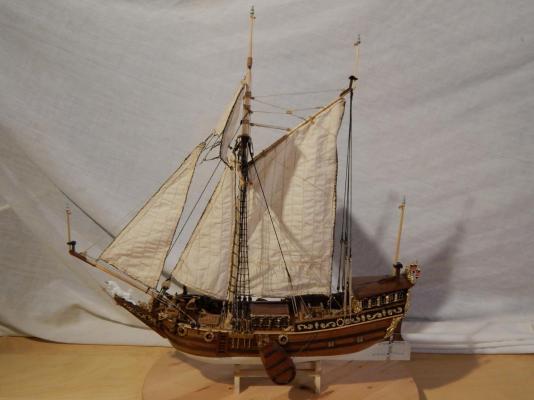
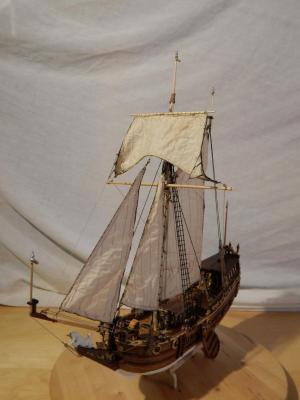
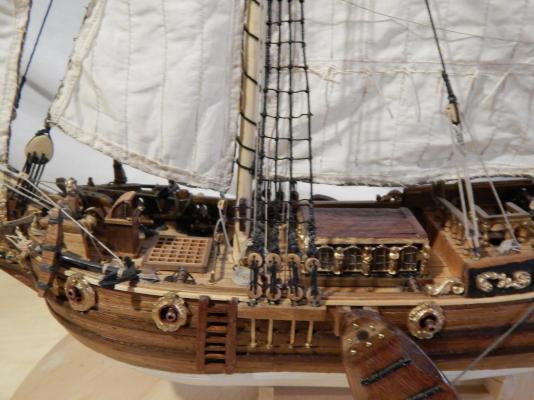
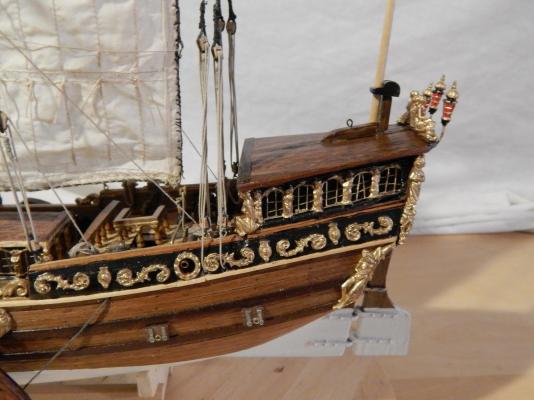
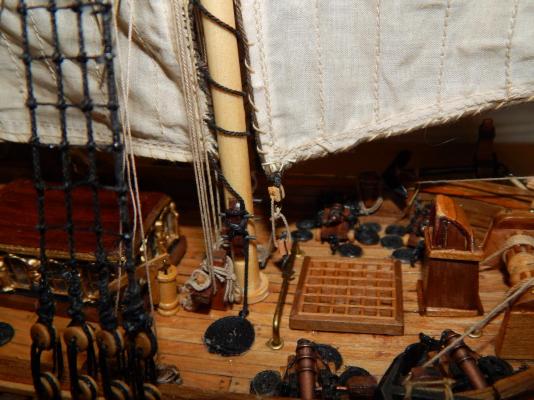
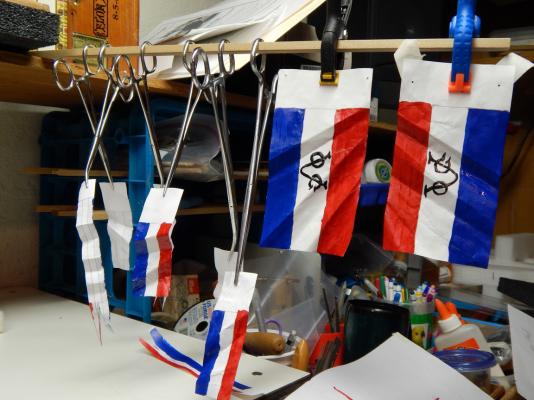
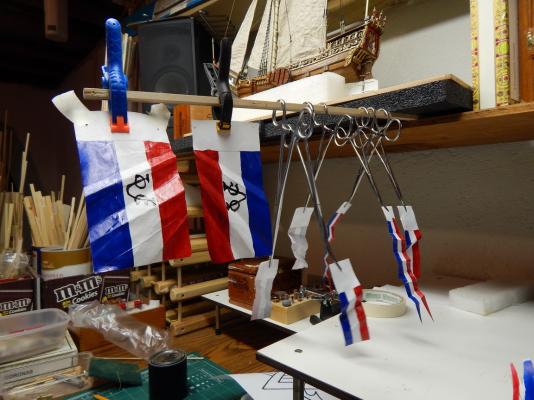
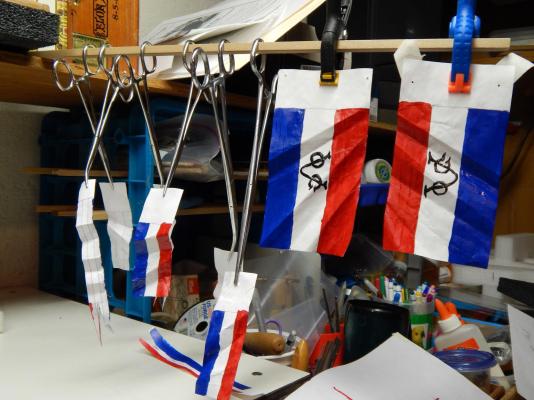
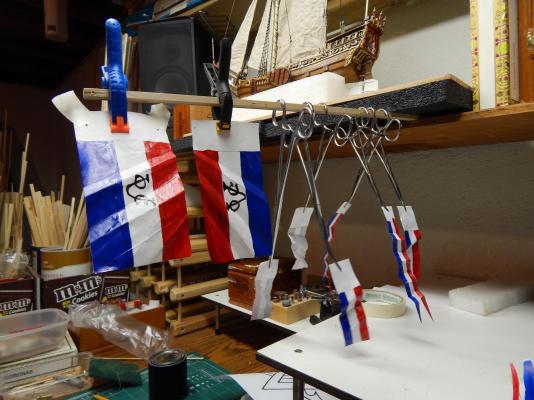
The First Royal Dutch Yacht Mary by flying_dutchman2 - FINISHED - Mamoli - 1646
in - Kit build logs for subjects built from 1501 - 1750
Posted
More details.